
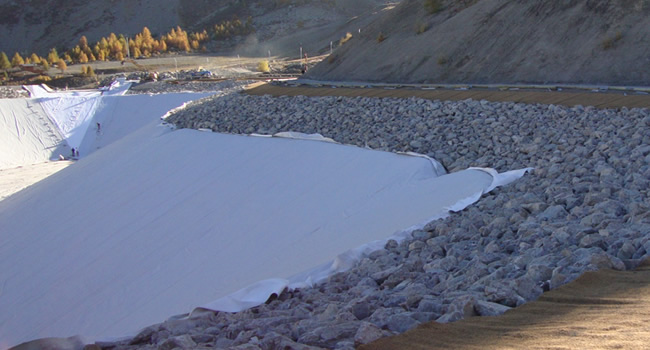
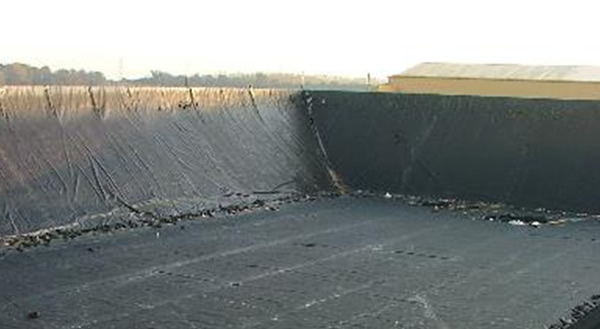
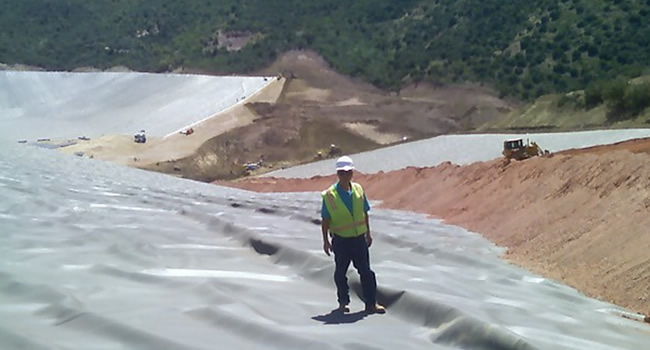
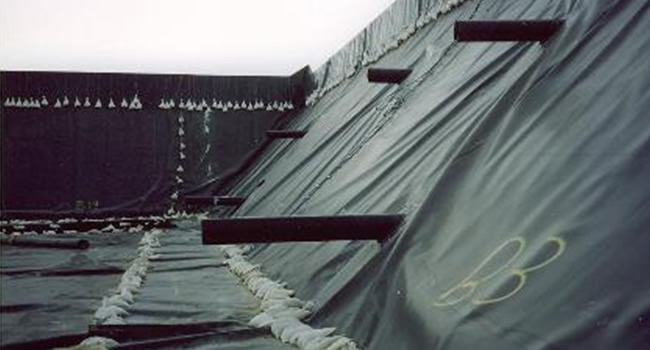
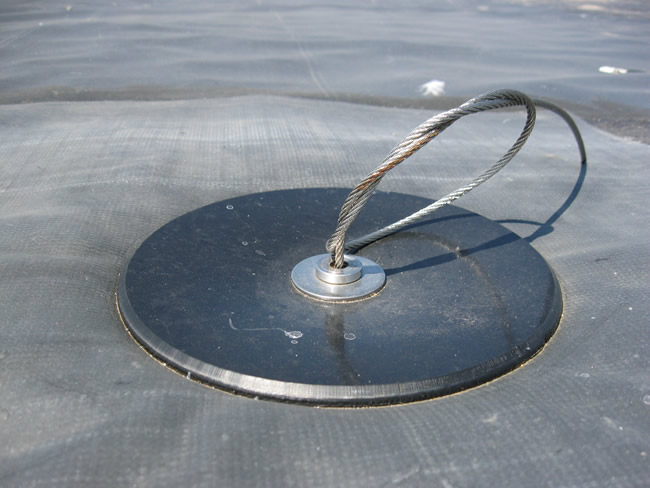
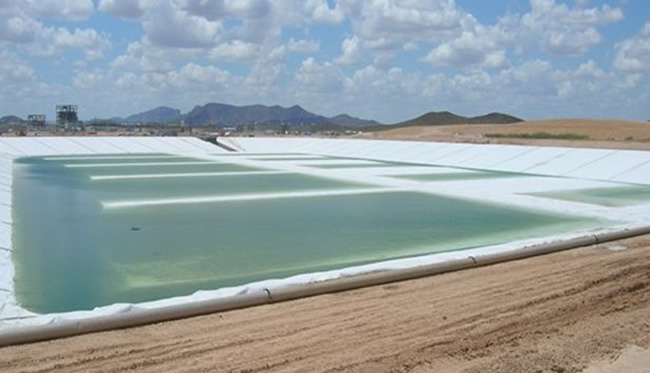
During EuroGeo 6, Dr. Ian D. Peggs, P.E., P.Eng chaired a special panel discussion on geomembrane wrinkles, bridging, uplift, and ballasting. The recorded session featured panelists Paul Guinard (SOPREMA), Adnan Berkay Özdemir (Atarfil), Michael Flynn (FLI Group), Catrin Tarnowski (GSE), and Richard Thiel (Thiel Engineering). We publish here, with permission of the EuroGeo 6 organizers (the Turkish Chapter of the International Geosynthetics Society) and the participating panelists, the session’s transcript, some slides from the presentations, and links to the full video record from the session.
We thank Ian Peggs and Wendy Cortez of I-CORP International for orchestrating this transcript release and all affiliated permissions.
RELATED: EuroGeo 6 Geomembrane Panel Discussion Parts 1 and 2
VIDEO & PPT RESOURCES
- VIDEOS: The transcription is comprised of 5 recording parts (18 minutes each). All video files may be found on the EuroGeo 6 special session page. The time stamps included in this transcript are in accordance with the recordings.
- SESSION POWERPOINT: The presentation slides are available for download here (PPT – 22 MB file). Slide references in this transcript refer to this file. NOTE: Not all images from the presentation are included in this special publication on Geosynthetica.
GEOMEMBRANE WRINKLES, BRIDGING, UPLIFT & BALLASTING, PART 3
The transcript picks up here with a continuation of Paul Guinard’s presentation from Parts 1 and 2. The video for this portion of the event can be viewed here.
We have to think about the “nature of the content” What is in the pond or landfill? Is the geomembrane exposed or not?. The geometry of your construction also matters. Is it a big landfill or a small pond?. The location also matters, a pond in Iceland or Burkina Faso will not face the same problems.
Once the geomembrane is chosen, you have to figure out how to insert it. You could limit the free length of the material to prevent wrinkles, use correct ballasting and use anchors and do not cover the material during thermic variation. Thermic protection is also important, the color of the material should be considered.
Open Floor Discussion
Ian Peggs opens the floor for open discussion:
Audience Member 1 asks the floor about sharp corners. Do you terminate both panels at that corner or do you wrap the panel around and make the weld on the flat side?
Michael Flynn: I personally would terminate them at the corner but each project is different. It depends on the design. These decisions have to be made on site by the project manager depending on the circumstances. As far as I am concerned, no geomembranes have any value in a site specific project unless they are installed properly. I will “go to my grave” believing that you have to install the product correctly, no matter what it is. It all down to the site management and project management.
Richard Thiel: Whenever I design ponds, I design them with round corners because we find a lot of bridging around sharp corners.
Audience Member 2 asks the floor what to do when wrinkles occur. Rick, in your specifications, you say to stop work but what if the wrinkles do not go away? How do you continue work?
Richard Thiel: Wrinkles almost always disappear with lower temperatures. We do a lot of night covering but there is the occasional really bad wrinkle that does not disappear. Then you have to make that decision: Do I cut this and make extrusion welds (which none of us like) or can I find a way to split it up or leave it? There is not one answer for that but we go to a lot of extent to not get in that position. I find that timing is everything and color helps a lot.
- J.P. Giroud: Rick, you proposed a maximum height of 50 to 75 mm. You proposed a ratio of 0.6 between height and width. Can we discuss those rules? I can better understand a ratio because if you have a flat shape (of a wrinkle) then it is more likely to flatten, whereas if you have a 75 mm high wrinkle with a very narrow base than you have a potential for the wrinkle to flip over. Could you both argue your point and tell us what is the best rule?
Richard Thiel: I had the same thought when I heard the ratio. The fact is when you have a large installation with polyethylene and start to get 50 to 75 mm wrinkles, this ratio will always work. The ratio becomes a problem when you have a big “floppy guy” (wrinkle) that comes down to the toe.
Catrin Tarnowski: I can support what Rick just mentioned. The German view is the same. Installation of top soil should stop once the wrinkle is higher than 50 mm. A wrinkle of that height would not have ratio below the mentioned figure (h/w=0.6).
- J.P. Giroud: As I understand what you (Richard Thiel) are saying that wrinkles that are less than 50-75 mm high, have a height to width ratio less than 0.6 so they should be okay? Are you suggesting such a correlation more or less? In other words you feel that smaller wrinkles are likely to be flattened so you do not have to worry about them? Is this the rational?
Richard Thiel: In response to J.P. Giroud’s comments and questions, I never measured it but that is the feeling.
- J.P. Giroud: On a recent project I made a distinction between the wrinkles with normal history (in the sense of loading direction normal being the vertical direction) and the wrinkles with lateral history. Some wrinkles were subjected to lateral load due to installation effects. That is the case where the wrinkles were pushed and accumulated at the bottom of the slope. The rule I gave to my client was to eliminate all the wrinkles that had lateral history. In that project we had semi instability, a movement of the slope itself so we had wrinkles that had lateral history. Wrinkles with lateral history will be more likely to have a high h/w ratio.
Richard Thiel: I agree. Those wrinkles are the hardest ones to remove.
Ian Peggs: How do you remove them?
Richard Thiel: It’s not easy. Of course we could cut them.
Ian Peggs: If you cut the wrinkle and overlap it to re-weld it, would you put a little keyhole at the end of the cut you’ve made? What about putting compensation in for allowing contraction during cold/low temperatures?
VIDEO PART 4 BEGINS HERE
Jacques: If you have a wrinkle at the bottom of the slope, then when it changes from hot weather to cold weather, that bump at toe of the slope doesn’t disappear completely but most of it is removed. Then when it heats up again, the bump gets bigger day after day. If you cut it and repair it and then the temperature goes down again, you get bridging. Then when it heats up again, you have to backfill it. Cutting a liner is like making a surgical operation; it won’t ever be as good as it was if it wasn’t cut.
Paul Guinard: That is very true when you have a landfill but when you have an exposed membrane with water in a basin, movement of the membrane can create wrinkles or bridging. Once the water starts coming you can’t stop it so you have to anticipate wrinkles and bridging and their consequences. We have to limit it and that depends on many things, like the product and the thickness.
Richard Thiel: There is a distinction between ponds (liquid containment) and liners covered with soil and loaded. With ponds, the failures were because of bridging popping a seam. I have never had a callback because of a wrinkle in a pond. The question that I am asking is: Are wrinkles in a pond a problem?
Michael Flynn: From the installation prospective, I think these problems can be mitigated on site by a competent installer. The pressure on the installer is from the cost side, the weather side, the wind and the rain. Backfilling at night has been mentioned but it is likely to get rid of the wrinkles but create many holes that you will never see. I think the importance has to be on the installation not the material since all materials are good quality and are impermeable when in panel form, but unless the installation and welding are carried out correctly, the joints will be weak points in the overall integrated project. It is the decisions made on site during the installation process that are critical to the success of the installation.
Ian Peggs: Who makes those decisions, the installer himself or the engineer?
Michael Flynn: The engineer who is not on site makes those decisions and that is wrong. It should be the installer. They should be in unison and both agree on a plan but the plan changes every day because the elements change every day and the project manager must adjust his work plan accordingly in order to make progress with the works. Therefore, the sequence of work might create bridging or wrinkling conditions that need not be there. It is all part of the installation that has to be managed.
Ian Peggs: Shouldn’t the kind of work that is necessary be defined by the project engineer because he knows what is going on with the installation? He knows the service conditions, the temperature and so on. Will the installer know all that to be able to direct what he does to achieve that objective?
Michael Flynn: I think that if the installer has the work plan and is fully aware of all aspects of the project, he can certainly manage the on-site works much better. Any installation plan has to be renewed on a daily basis depending on the conditions, whether it’s wind, rain, sunshine or something else. Often there is pressure from the client to backfill when the installation is not ready for backfilling. That can then create installation problems further on. All of the synthetic products have their own natural limitations and advantages. It is the fixing of the material on site that is unnatural. This needs to be recognized and respected for what it is. It really is a skill and has to be valued but it is often forgotten and is always undervalued. The drive to get the project finished compromises the professional installation decisions that would otherwise be made if time and cost allowed.
- J.P. Giroud: I would like to ask you a question about bridging or trampolining. Rick, If you have trampolining and if you apply pressure on it by filling a reservoir, the strain generated is very small. Therefore it is unlikely that the geomembrane will fail. You said that you have seen this failure. You probably never saw an outright failure of the geomembrane with tension. The problem is the seams that are in an area where there is a risk of trampolining. Earlier you agreed that panels should be terminated at the corners, which means that there will be a seam at the corner, but the corner is the location where trampolining will occur so there is a problem.
Richard Thiel: In the example presented by one of the speakers today, he (Adnan Özdemir) provided us the calculation that said for a 20° difference, we will get about 0.43% strain. The question in my mind is: What percent of strain is allowable to bury in a trampolining situation?
- J.P. Giroud: 0.4 % is certainly okay, even for a HDPE. 0.25 % is totally unjustified. I have never seen it published and I have never seen any demonstration so that is not a real number. 0.4 % is acceptable for all geomembranes. The question is: Should we have in our designs seams, as much as possible, away from the area where trampolining is likely to occur? Therefore, this brings us to the discussion before. Should we have seems in the corners? I understand that it may be easier for installation but it may create a problem.
Catrin Tarnowski:I would like to say that the 0.25% is a BAM (Bundesanstalt für Materialforschung und Prüfung) regulation from Germany on the maximum strain on the geomembrane and this is related with the local puncture strength of the material. This has nothing to do with the allowable, limiting strain rate. This is discussed to be for 3-5% for good quality HDPE. The lesser the quality of the material the more critical it is.
- J.P. Giroud: I agree. The allowable strength of a HDPE is in the order of 3-5% but not 0.25. I have never seen any justification for the 0.25 for puncture strength and yesterday when I asked the question I got the answer “we don’t know it, maybe it is written somewhere and we missed it”. It is a challenge for German team to provide a demonstration of the 0.25. Back to trampolining and the fact that that the trampolining is acceptable for a geomembrane but not for the seams. Should we change the strategy and not have seams in corners?
Michael Flynn: I do not think that the seaming in the corners is causing the trampolining. It is not causing (trampolining), it may be the victim of trampolining. Should we avoid having seams in the areas where trampolining is likely to happen? Which is in corners, in everything angle that is concave in shape.
Paul Guinard: Do you think that there is a difference in strength between a weld made in the corner and a weld 50 cm away from the corner? I do not think there is much difference.
- J.P. Giroud: No, it has nothing to do with the strength but the strain is very different in the area that is subjected to trampolining. If we have a shape that is concave, we can calculate the distance of trampolining impact and have the seams beyond (that distance).
Catrin Tarnowski: I would try to avoid seams where there is a likelihood of bridging. We have good design practices which avoid corner seams. They should be placed at the bottom and should not be at the toe of the slope. That is a design approach.
- J.P. Giroud: I agree with you but we have just discussed that there is a recommendation to put seams at the corner of a rectangular pond.
Richard Thiel: In the corner of the pond, where you have three corners coming together, it is very difficult not to have seams. It actually occurs in the worst place. This is exactly the places where we had these problems in multiple projects.
- J.P. Giroud: I don’t mean it is easy. I understand it is easier to install seams in the corner but at the same time I hear you (Richard Thiel) say that there are a lot of seam failures under those circumstances. I hear Catrin saying we don’t put seas at the toes and that is good. I’ve seen that recommendation may times.
Catrin Tarnowski: An additional precaution may be to put sufficiently thick geomembranes so that even if bridging does occur, the material would not be in a critical condition. If you have to consider doing an extrusion weld with a very thin material, and you have to place it in a critical area, it becomes a critical case. In that case, you might consider a thicker material just in that area.
Michael Flynn: In 30 years of installation experience, I have never seen a failed weld in a corner. It is a theoretical weakness and that exists in the theoretical world but I have not seen it on a site installation where I have been involved.
Richard Thiel: This is the problem. Obviously the weld was not the best but it passed all the CQA but in fact it is the weak spot. I have seen it in tanks and ponds. The corners are the problem. It is not that the fusion seam that runs down through the corner, it is the extrusion weld that occurs in the unusual geometry of the triple corner.
Boyd Ramsey: There’s a group called Platypus that makes an anchoring product and they have done a lot in changing the design and the effectiveness of exposed caps and covers. My question is: Has anyone used a soil anchor as a tool for wrinkle management?
Ian Peggs: My guess will be “no” but I have no real justification. Has anyone seen anything like this?
VIDEO FOR PART 5 BEGINS HERE
Alan: Not so much as a wrinkle management tool I’ve come across the Platypus anchors being used on caps and exposed dams where there is wind concentration. With the correct methods of spreading the localized stress, it worked fine.
Peter (Gentleman from South Africa): I have had very good experience managing wrinkles through the use of relatively inexpensive co-extruded textured liner. My experience is that by using the textured liner, thermal stresses are distributed into the subgrade. My experience is that you get a greater distribution of lower wrinkles so that when you do your cover those wrinkles flatten and the chance of folding over is very low.
- J.P. Giroud: When I published the theoretical studies of wrinkles in 1992, I indicated that the friction angle was the key factor and the coefficient of thermal expansion governs the amount of expansion but does not govern the amount of wrinkles. If you have a high friction angle, you will have less space between the wrinkles and therefore the wrinkles will be smaller because you will have more. It has been checked experimentally by the research at Queens University. This is what we want: more wrinkles but generally very small. PVC has almost the same coefficient of thermal expansion as HDPE and you see no wrinkles because we have an infinite amount of zero height wrinkles so the total expansion is the same. In material selection we could select a white material which will decrease the temperature and decrease the expansion. We can have textured material on the bottom face so we will have more wrinkles with smaller height.
Audience member 2: I have a comment. Should we not re-look at the value chain starting from the design and what we are really putting out there. In the sense of cost and time and also the experience of people. Over the years, in my experience, there is so much focus on the time the designer is allowed that we overlook the things during construction and CQA and also when advising the client of the extra costs. We need to start thinking about the numbers and the time needed to ensure the client is getting what they want.
Michael Flynn: I’d like to support that. I think all of the risk is on the project and the project cost and a bit more money spent on geomembrane and geosynthetic installation costs could make a much better project if the project site has enough time and resources to actually do the job correctly.
Jacques: I am wondering why engineers continue to specify black geomembranes? We get less wrinkles with white or tan and you can still meet the specifications; especially since they cost the same.
Peter: I think wind uplift is as much as a problem to the creation of wrinkles and it is more difficult to manage. It is a combination of good design and good installation practice. It requires the engineer and the client to work with the installation contractor to make sure that they avoid wind uplift. That is one thing you cannot put right. Once the wind moves 4 or 5 tons of geomembrane, you are not going to be able to get rid of the wrinkle and you are going to end up with wrinkles more than 50 mm high. That is certainly something to consider. I too have seen the Platypus anchor type to hold down liners in empty lagoons. One of the key solutions is to prevent air from getting under the material in the first place. So cut and fill reservoirs without actually sealing the bond above the ground. Those are very basic engineering principles, people forget about.
- J.P. Giroud: What about the difference between HDPE and LLDPE regarding the wrinkles?
Catrin Tarnowski: There is a crystallinity difference in both products so LLDPE will not show as much wrinkling as an HDPE does. If you design with anchor applications there is always a question, what may be the solution for it? You can have the same amount of wrinkles in any product but the difference is still there.
- J.P. Giroud: Yes, obviously. The theory shows that the height of the wrinkle is governed by the bending strains. The bending resistance of HDPE is much greater than LLDPE so if you have the same coefficient of thermal expansion, the LLDPE will have more wrinkles but they will be smaller in height. This is what the theory predicts very clearly.
Catrin Tarnowski: The experience is not that they are smaller, it is just the amount of the wrinkles is less.
- J.P. Giroud: Did you measure the coefficient of thermal expansion?
Catrin Tarnowski: No. That was a question that I wanted to ask the experts here. Do we measure the coefficient at different temperatures? Not every product has the same coefficient. Also, in my experience, if you have very low temperatures the coefficient is lower but I have never measured it.
- J.P. Giroud: It would be very interesting to measure the coefficient of thermal expansion because we forget that the main parameter for the height of wrinkles is the bending strength of the geomembrane.
Catrin Tarnowski: What is missing here is that we do not specify the dimensional stability of the products and dimensional stability is important for laying flat characteristics. It is not the coefficient on its own. This is something that should be considered and GM13 does not focus on it. It’s like it is not relevant and I think it is relevant. German specifications foresee such a value and they are good. Installers know if you have good dimensional stability and low shrinkage of your product you have better installation time. If you consider that you have low shrinkage on the edges and if you have high shrinkage in the middle, you will have waves which will occur during day time and they will not go away because the shrinkage behavior is different in the product and the material wants to move to the best position.
- J.P. Giroud: I have photos taken in the field where I saw geomembrane made with flat die and the wrinkling is not same in the center of the panel and on the edges. This material does not have the same dimensional stability in the edges and the center. Whereas the blown film is more uniform because every point has the same history. İn the flat dye, my impression is that there is a difference in history between the edges and the center.
Catrin Tarnowski: You can manage both. We produce both products and we know how do it.
Ian Peggs: On that note, I have got 1:00 exactly, so we will wrap it up.











